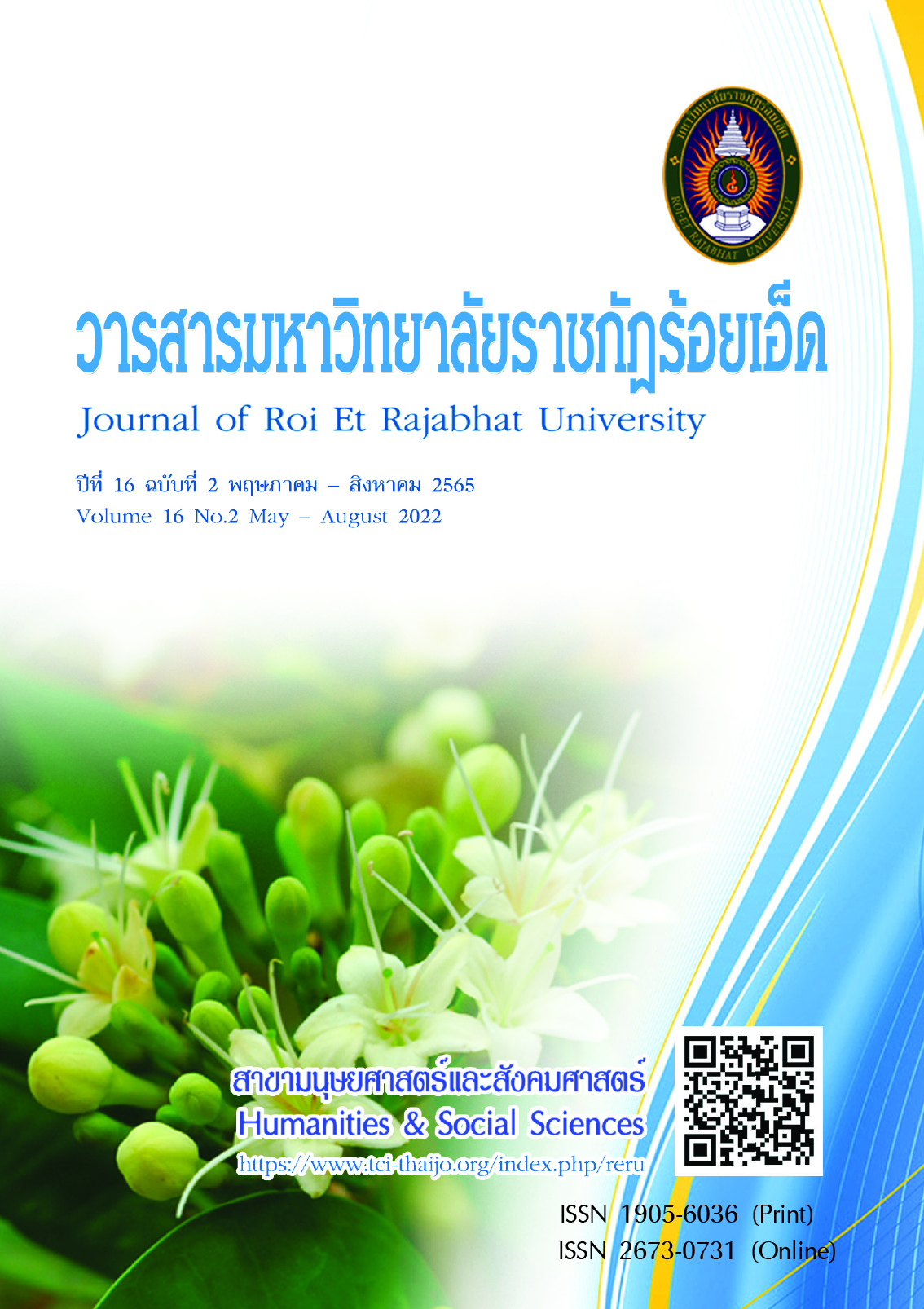Public Participation in Water Resources Management Case Study of Lam Dome Yai River Basin
Keywords:
Participation, Water Management, Lam Dome Yai River BasinAbstract
This research had objectives to 1) study the socio-economic conditions in the Lam Dome Yai River area, 2) study the participation and needs of people in water resource management, and 3) study solutions for solving problems in water resource management. Study areas were in 6 districts with an area adjacent to the large dome. The data was collected by using a questionnaire. The study population were people who use water, folk philosopher, persons respected by the community, the village headman and members of the local government organizations total 91,048 people. The sample group used in the study of 400 people. The statistics used to analyze the data were mean and standard deviation. By bringing the information obtained by the questionnaire leading into a participatory meeting with a target group of 30 people/stage. The target group consisted of local community leaders, folk masters, religious leaders and community representatives in total 10 stages.
The results of the study showed that economic conditions of most population do rice farming as their main occupation, do crop-farming as a secondary occupation, income were less than 5,000 baht per month and had a burden and debt. Social conditions, most people lived in the area for more than
25 years and did not intend to relocate to other areas. The sample group had 73.30% of their own holding land, with most of them having their own title deeds in terms of participation in water management.
It found that the sample group participated at a moderate level. They took part in activities from time
to time and took part in water resource management four to seven times a year. And they needed to participate in overall at a moderate level. As for problems and obstacles to the participation of people, the most common problem was people's lack of knowledge and ability to solve problems arising with water resources at 49.00 %. Followed by the problem of water resource management that people could not do it by yourself, they needed to join other organizations for success at 46.00%. And lack of knowledgeable leaders to solve water resource problems at 44.50% respectively. The results of a participatory meeting stage to achieve sustainability, there must be a working group at the sub-district, district and provincial levels,
in order to coordinate the request for assistance. People must be an integral part of planning and reporting the need for an organization in charge of water resources. So that the organization in charge would take action to meet the needs of people who use water and to find guidelines and budget for water resources management
References
กมล หอมกลิ่น, โสวัตรีณ ถลาง และวิพักตร์ จินตนา. (2556). การปรับตัวทางวัฒนธรรมของชุมชนต่อการจัดการทรัพยากรน้ำในพื้นที่ที่ได้รับผลกระทบจากการสร้างฝายลำโดมใหญ่ ตำบลไร่ใต้ อำเภอพิบูลมังสาหาร จังหวัดอุบลราชธานี. วิทยานิพนธ์ ศิลปศาสตรมหาบัณฑิต สาขาวิชาพัฒนาสังคม. กรุงเทพฯ: มหาวิทยาลัยเกษตรศาสตร์.
กวี วงศ์พุฒ. (2535). ภาวะผู้นำ (พิมพ์ครั้งที่ 2). กรุงเทพฯ: ศูนย์ส่งเสริมวิชาชีพบัญชี กรุงเทพ.
เขมิกา ยามะรัต. (2527). ความพึงพอใจในชีวิตของคนชรา: กรณีข้าราชการบำนาญกระทรวงเกษตรและสหกรณ์. วิทยานิพนธ์ สังคมสงเคราะห์ศาสตรมหาบัณฑิต สาขาวิชาสังคมวิทยา. กรุงเทพฯ: มหาวิทยาลัยธรรมศาสตร์.
ฉัตรพงษ์ สุขเกื้อ, ชาตรี วิระสิทธิ์ และประนอม สุขเกื้อ. (2556). การมีส่วนร่วมของชุมชนต่อการอนุรักษ์แม่น้ำเจ้าพระยา ในจังหวัดพระนครศรีอยุธยา. นนทบุรี: มหาวิทยาลัยเทคโนโลยีราชมงคลสุวรรณภูมิ.
ชลธร ทิพย์สุวรรณ. (2557). ปัจจัยที่นำไปสู่การบริหารจัดการทรัพยากรน้ำแบบบรูรณาการลุ่มน้ำสาขาแม่ริม. ดุษฎีนิพนธ์ การศึกษาดุษฎีบัณฑิต สาขาวิชาภูมิภาคลุ่มน้ำโขงและสาละวินศึกษา. เชียงใหม่: มหาวิทยาลัยราชภัฏเชียงใหม่.
ณรงค์ เส็งประชา. (2541). มนุษย์กับสังคม (พิมพ์ครั้งที่ 4). กรุงเทพฯ: โอเดียนสโตร์.
นิรันดร์ จงวุฒิเวศย์. (2527). กลวิธีการเสริมสร้างการมีส่วนร่วมของประชาชนในการพัฒนาชนบท. กรุงเทพฯ: ศูนย์ศึกษานโยบายสาธารณสุขมหาวิทยาลัยมหิดล.
บุญชม ศรีสะอาด. (2557). การวิจัยทางการวัดผลและประเมินผล. กรุงเทพฯ: สุวิริยาสาสน์.
บุญธรรม กิจปรีดาบริสุทธิ์. (2553). เทคนิคการสร้างเครื่องมือรวบรวมข้อมูลสำหรับการวิจัย (พิมพ์ครั้งที่ 7). กรุงเทพฯ: ศรีอนันต์การพิมพ์.
เบญจพรรณ สุวรรณท้าว. (2558). ศึกษาการมีส่วนร่วมของประชาชนในการจัดการขยะมูลฝอยขององค์การบริหารส่วนตำบลนาเลิง อำเภอเสลภูมิ จังหวัดร้อยเอ็ด. วารสารมหาวิทยาลัยมหามกุฏราชวิทยาลัย วิทยาเขตร้อยเอ็ด, 5(1), 212-238.
เมธาวี นินนานนท์. (2551). การใช้สัตว์หน้าดินในการบ่งชี้ปริมาณสารอินทรีย์ในสิ่งแวดล้อมบริเวณแม่น้ำปะกง. วิทยานิพนธ์ วิทยาศาสตรมหาบัณฑิต. อุบลราชธานี: มหาวิทยาลัยบูรพาใหญ่.
สุปราณี โล่ภักดีสวัสดิ์ และวิโรจน์ เจษฎาลักษณ์. (2558). การมีส่วนร่วมของประชาชนในการบริหารจัดการทรัพยากรน้ำ โครงการส่งน้ำและบำรุงรักษา เขื่อนขุนด่านปราการชล อันเนื่องมาจากพระราชดำริ จังหวัดนครนายก. กรุงเทพฯ: มหาวิทยาลัยศิลปากร.
สุพัตรา สุภาพ. (2548). สังคมวิทยา. กรุงเทพฯ: ไทยวัฒนาพานิช.
อภิเดช สิทธิพรหม และเทพศักดิ์ บุณยรัตพันธุ์. (2558). ศึกษาการมีส่วนร่วมของประชาชนในการจัดทำแผนพัฒนาท้องถิ่นขององค์การบริหารส่วนตำบลรอบเมือง อำเภอเมือง จังหวัดร้อยเอ็ด. วารสารอิเล็กทรอนิกส์การเรียนรู้ทางไกลเชิงนวัตกรรม (e-JODIL), 8(1), 137-149.
อคิน ระพีพัฒน์. (2527). การมีส่วนร่วมของชุมชนในการพัฒนาชนบทในสถานสงเคราะห์วัฒนธรรมไทยในการมีส่วนร่วมของประชาชนในการพัฒนา. ศูนย์ศึกษานโยบายสาธารณสุข. กรุงเทพฯ: มหาวิทยาลัยมหิดล.
Taro, Y. (1973). Statistics: An Introductory Analysis (3rd ed.). New York: Harper and Row Publications.
Cohan, J. M. and Uphoff, N. T. (1997). Rural Development Participation: Concepts and Measure for Project Design. New York: Comet University.
Downloads
Published
How to Cite
Issue
Section
License
Copyright (c) 2022 Roi Et Rajabhat University

This work is licensed under a Creative Commons Attribution-NonCommercial-NoDerivatives 4.0 International License.
บทความที่ได้รับการตีพิมพ์เป็นลิขสิทธิ์ของวารสารมหาวิทยาลัยราชภัฎร้อยเอ็ด
ข้อความที่ปรากฏในบทความแต่ละเรื่องในวารสารวิชาการเล่มนี้เป็นความคิดเห็นส่วนตัวของผู้เขียนแต่ละท่านไม่เกี่ยวข้องกับมหาวิทยาลัยราชภัฎร้อยเอ็ด และคณาจารย์ท่านอื่นๆในมหาวิทยาลัยฯ แต่อย่างใด ความรับผิดชอบองค์ประกอบทั้งหมดของบทความแต่ละเรื่องเป็นของผู้เขียนแต่ละท่าน หากมีความผิดพลาดใดๆ ผู้เขียนแต่ละท่านจะรับผิดชอบบทความของตนเองแต่ผู้เดียว





